Prestonpans
Prestonpans (/prɛstənˈpænz/ Scottish Gaelic: Baile an t-Sagairt) is a small fishing town east of Edinburgh, Scotland, in the unitary council area of East Lothian. The population as of 2016 is 10,410. It lies approximately 2 miles to the north of the larger older town of Tranent. It is the site of the [[Battle of Prestonpans first called the battle of Gladsmuir then renamed the Battle of Tranent due to parish locations. Much later it was renamed the battle of Prestonpans although no evidence has of any battle having taken place in or near the village on the shore as it was in those times.]], fought in 1745, and has a history dating from the eleventh century. The town's important historical architecture includes: Preston Tower and the doocot and the local Mercat Cross, which is the only one of its kind in Scotland which remains in its original form and location. Prestonpans is "Scotland's Mural Town", with many murals depicting local history.
| Prestonpans | |
|---|---|
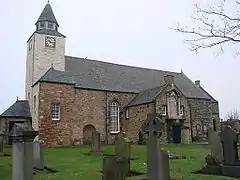 Prestonpans Old Parish Church | |
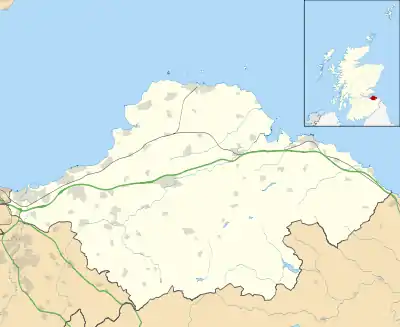 Prestonpans 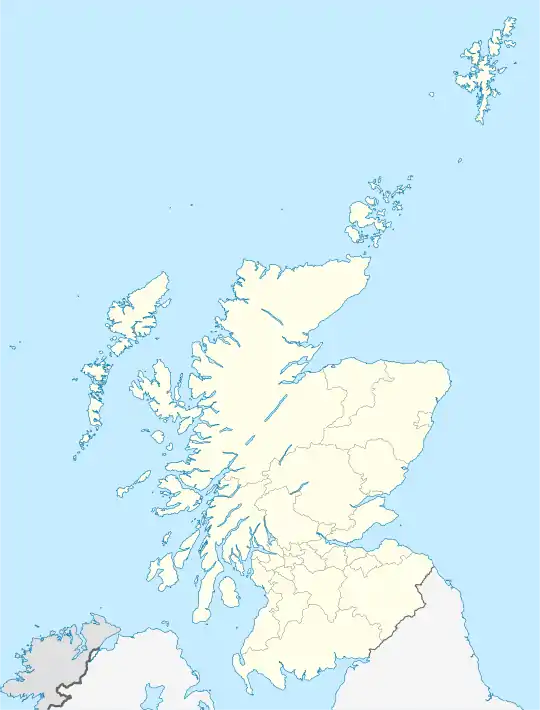 Prestonpans Location within Scotland | |
| Population | 10,410 (mid-2016 est.)[1] |
| Demonym | Panner(s) |
| OS grid reference | NT401745 |
| Council area | |
| Lieutenancy area | |
| Country | Scotland |
| Sovereign state | United Kingdom |
| Post town | Prestonpans |
| Postcode district | EH32 |
| Dialling code | 01875 |
| Police | Scotland |
| Fire | Scottish |
| Ambulance | Scottish |
| UK Parliament | |
| Scottish Parliament | |
History

According to certain stories Prestonpans was founded in the 11th century by a traveller named Althamer, who became shipwrecked on the local beach/coastal area. Finding it impossible to get home, the survivors of the wreck decided to remain where they were and founded a settlement named Althamer in honour of their leader. Whether this story is true or not is a matter of opinion, however, when the monks of Newbattle and Holyrood arrived in the district in 1184 there was already a settlement named 'Aldhammer' on the site of what is now Prestonpans. The monks gave the settlement their own name, Prieststown or Prieston. Because of the salt manufacturing carried out by the monks using pans on the seashore, the town's name would later develop into Salt Prieststown and Salt Preston, and finally Prestonpans.
One of the first post-Reformation churches was built in Prestonpans in 1596, for and at the expense of the new minister, John Davidson.[2] The church was greatly re-modelled in 1774. Ten years after the original building of the new church, Prestonpans became a Parish in its own right, having previously formed part of the Parish of Tranent.[3]
Industry
Salt panning was a very important industry in the early history of Prestonpans. By the beginning of the fifteenth century there were 10 salt works belonging to the town capable of producing between 800 and 900 bushels of salt per week. However, Prestonpans was not a one-industry town, and many other industries flourished in Prestonpans and contributed towards the town's growth. The discovery and mining of coal by the Newbattle monks in the early thirteenth century was arguably the first instance of coal mining in Britain. The mining of coal in Prestonpans began in the year 1210, and continued for centuries.
Prestonpans at one time had sixteen breweries however, today there are none. The oldest brewery in Prestonpans belonged to the Fowler family and was built in 1720. The Fowlers obtained it in 1756 and it was in production until the 1960s. The building was demolished in 1989 to build flats. There was a soap works in the town which at one time had an output of 90,000 pounds (41,000 kg) per annum, and also several potteries and brickworks.
The town was served, for several hundred years, by the harbour at nearby Prestongrange, known as Morrison's Haven or "Acheson's Haven". Fishing boats sailed from the harbour and herring was the most important catch. The harvesting of oysters was a lucrative industry up to the early twentieth century.
Battle of Prestonpans; Heritage Trust
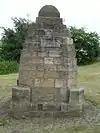
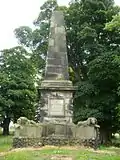
The Battle of Prestonpans (also known as the Battle of Gladsmuir) was the first significant conflict in the second Jacobite Rising. The battle took place on 21 September 1745. The Jacobite army loyal to James Francis Edward Stuart and led by his son Charles Edward Stuart defeated the army loyal to the Hanoverian George II led by Sir John Cope. The victory was a huge morale boost for the Jacobites, and a greatly mythologised version of the story entered art and legend. A memorial to the Battle of Prestonpans in the form of a modest stonemason-built cairn sits close to the battle site. An earlier (and tellingly, much larger and more impressive) monument to Colonel James Gardiner, a Hanoverian who was mortally wounded on the field of battle, was also erected in 1853 near Bankton House where the Colonel lived. It was sculpted by Alexander Handyside Ritchie. Each year on the anniversary of the battle, a Battlefield Walk is organised by local historians, and in September 2008 the Battle of Prestonpans 1745 Trust organised a symposium on local battlefields. A memorial in the parish church commemorates "John Stuart of Phisgul...barbarously murdered by four Highlanders near the end of the Battle".

In 2006, the Battle of Prestonpans 1745 Heritage Trust was established on the initiative of the local people to ensure much better presentation and interpretation. It attracted private and Heritage lottery funding to achieve some of its initial goals.
Plans include a Living History Visitor Centre in close proximity to the battlefield, authentic battle re-enactments as part of East Lothian's Triennial Battle Cycle, battle-related storytelling, paintings by Andrew Hillhouse, new historical novels, and a new 'Flowering of the Arts' including embroidery. A "Battle Bus" helped to promote the project until 2012 by when the 105 metre Battle of Prestonpans Tapestry had become a major celebrity. From September 2008, biennial symposia are being convened to explore the past, present and future of the East Lothian battlefields of Prestonpans, Dunbar and Pinkie Cleugh. In 2013, the Battle Trust published Arran Johnston's "Blood Stain'd Fields – the Battles of East Lothian" with a Foreword by the 19th Duke of Somerset, a descendant of the English victor at Pinkie Cleugh. The 4th such biennial Symposium in 2014 saw very wide involvement from battlefields across Scotland and an Accord was reached to establish a Scottish Battlefields Trust working in partnership with the UK Battlefields Trust.
Details of all the Trust's activities can be found at its website @ www.battleofprestonpans1745.org and these include the Alan Breck Regiment of Prestonpans Volunteers established by the Trust to ensure annual re-enactments. As well as Highlanders, the Regiment includes members of the redcoat Edinburgh City Guard.
Battlefield Archaeology
In 2008 the Trust commissioned Glasgow University Archaeological Research Division ("GUARD") to undertake a comprehensive survey, followed by selective excavation, of the battlefield.[4] Although the site of the main battlefield is readily located today, fixed by such surviving features as the tramway embankment, interim findings announced in April 2010 indicate that the true site of the Highlanders' charge, based on concentrations of musket balls and other evidence, is 500 yards to the east of the accepted location (55°57′50″N 2°56′49″W).[5][6] The battlefield has been inventoried and protected by Historic Scotland under the Scottish Historical Environment Policy of 2009.[7]
Great controversy has arisen in 2014 as proposals to redevelop the industrial activities close by the battle site have actually impinged on it. Historic Scotland has taken the view that such activities will have a minimal impact and it is in the national interest that they must be allowed. The local community has refused to accept such an outcome and is pledged to campaign to have it reversed.
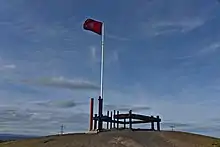
The battlefield benefits from a pyramidal viewpoint sculpted from an old coal bing at Meadowmill, atop which flies Prince Charlie's battle flag to mark where a series of interpretation boards can be found. There are a further seven information panels around the battlefield, regular guided walks and commemorative events. With support from Bord na Gaidhlig road and walkway signage now includes the Gaelic which was spoken by the majority of Highlanders at the battle. The Doo'cot at Bankton House now acts as an interpretation site for the life of Colonel Gardiner. An APP for the Battlefield Walk, the Prestonpans Tapestry [see below] and the 1722 Waggonway which crosses the battlefield is available for free download from Apple and Android @ prestonpans 1745
Prestonpans Tapestry
The Prestonpans Tapestry was unveiled on 26 July 2010. With 105 panels (each 1m long), it is about 100 ft (30m) longer than its inspiration, the Bayeux Tapestry. Inspired by Gordon Baron Prestoungrange, designed by local artist Andrew Crummy, and executed by over 200 volunteer embroiderers, the tapestry has already toured Scotland, England and France. Venues included the Scottish Parliament, the Scottish Storytelling Centre, Cockenzie power station and countless locations from Eriskay along the route The Prince took prior to the battle. In Autumn 2013, the Tapestry was a Guest Exhibit alongside the Bayeux Tapestry itself, in Normandy, and subsequently at Pornichet/ St Nazaire from whence the Prince embarked to begin his campaign in 1745.
- "The Scotsman", 7 July 2010, "Creators at great lengths to find a place for giant tapestry").
- BBC News, 25 July 2010, Bonnie Prince sewn up in tapestry
- Prestonpans Tapestry website
Modern Prestonpans

The war memorial stands near the town centre but is slightly obscured by the flanking buildings. It is a fine sculpture of a "Jock" (Scottish soldier) in bonnet and greatcoat by William Birnie Rhind, 1921.
Adjacent to the war memorial is a bronze plaque dedicated to the memory of those who lost their lives in the Spanish Civil War.
There is now no salt or mining industry in the area. The town has developed considerably over the last few years. New housing has been built on greenbelt and there is potential for more affordable housing in the town. There remains a thriving community spirit. A two-week festival in early summer links Prestonpans with neighbouring Cockenzie and Port Seton, called The Three Harbours Festival.
The town has two primary schools, Preston Tower Primary School and St, Gabriels and the comprehensive Preston Lodge High School. Prestonpans railway station is on the Edinburgh – North Berwick line. The local non-league football team Preston Athletic plays its home games at the Pennypit Park in the town, as does the local rugby team Preston Lodge RFC.
Prestonpans also has the popular and famous Royal Musselburgh Golf Club, the sixth-oldest golf club in the world (and is still home to The Old Club Cup, the world's oldest golfing trophy still being played for) and the town's cricket team, Preston Village Cricket Club.
The Prestonpans Murals Trail has become popular over the last few years. In 2006 it hosted the Global Murals Conference.
In 2006, Prestonpans and the neighbouring towns of Cockenzie, Port Seton and Longniddry were twinned with the town of Barga, Tuscany, Italy.[8]
In 2010, the Prestonpans Tapestry was completed and has been touring Scotland and England.
In October 2011, Prestonpans was awarded Fairtrade Town status.
Notable residents
- Thomas Alexander, military surgeon In the Crimean War
- Scott Clark, former Hibernian FC Football Player.
- John Davidson, reformer who set up the church and the school[9]
- Robert Dick, inspector of salt works and prisoner on the Bass Rock.
- John Fian, a purported sorcerer executed in 1591.
- James Mylne, Poet, was Laird of Lochill, a small estate near Prestonpans, Haddingtonshire.d1788 [10]
- Allan Jacobsen, rugby union player.
- Same Shaw, recipient of the Victoria Cross.
- Josh Taylor, Professional Boxer.
- Martin Whitfield former schoolteacher at Prestonpans Primary School, and the Labour Member of Parliament (MP) for East Lothian (2017–2019).
- Tam Paton, Thomas Dougal "Tam" Paton was a pop group manager, most notably of the boy band the Bay City Rollers.
- Bill Joyce, Former West Ham United, Tottenham Hotspur and Bolton Wanderers footballer.
See also
- Barony of Preston and Prestonpans
- Category: People from Prestonpans
- John Muir Way
- List of places in East Lothian
- Prestongrange Parish Church
References
Citations
- "Mid-2016 Population Estimates for Settlements and Localities in Scotland". National Records of Scotland. 12 March 2018. Retrieved 30 December 2020.
- Buildings of Scotland: Lothian, by Colin McWilliam
- Scott 1915, p. 387.
- Pollard, Tony; Ferguson, Natasha (2008). "Prestonpans battlefield archaeological project" (PDF). Centre for Battlefield Archaeology, University of Glasgow. Retrieved 13 June 2010.
- Pollard, Tony; Ferguson, Natasha (26 February 2010). "Prestonpans Battlefield Project Report" (PDF). Glasgow University Archaeological Division. Retrieved 13 June 2010.
- MacLeod, Fiona (21 April 2010). "Charge of the right brigade: true site of Battle of Prestonpans found". The Scotsman. UK. Retrieved 13 June 2010.
- "Inventory battlefields". Historic Scotland. Retrieved 12 April 2012.
- Prestonpans: Battles of the '45
- Rogers 1874b, pp213-215.
Sources
- Chalmers, George (1887). Caledonia : or, a historical and topographical account of North Britain, from the most ancient to the present times with a dictionary of places chorographical & philological. 4. Paisley: Gardner. pp. 522–526. Retrieved 13 June 2020.
- Chisholm, Hugh, ed. (1911). "Prestonpans". Encyclopædia Britannica (11th ed.). Cambridge University Press.
- Cunningham, W. Bruce (1845). "Parish of Prestonpans". The new statistical account of Scotland by Society for the Benefit of the Sons and Daughters of the Clergy. Edinburgh and London: William Blackwood and Sons. pp. 304–316. Retrieved 29 September 2018.
- Groome, Francis, Hindes (1885). "Prestonpans". Ordnance gazetteer of Scotland : a survey of Scottish topography, statistical, biographical, and historical. 3. Edinburgh: T.C. Jack. pp. 227-231. Retrieved 6 June 2020.
- Groome, Francis, Hindes (1895). "Prestonpans". Ordnance gazetteer of Scotland : a survey of Scottish topography, statistical, biographical, and historical. 5. Edinburgh: T.C. Jack. pp. 225-229. Retrieved 6 June 2020.
- Lewis, Samuel (1851). "Prestonpans". A topographical dictionary of Scotland, comprising the several counties, islands, cities, burgh and market towns, parishes, and principal villages, with historical and statistical descriptions: embellished with engravings of the seals and arms of the different burghs and universities. 2. London: S. Lewis and co. pp. 393-395. Retrieved 6 June 2020.
- Miller, James (1900). Lamp of Lothian: or, the history of Haddington, in connection with the Public Affairs of East Lothian and of Scotland, from the earliest records to 1844. Haddington: W. Sinclair. Retrieved 30 September 2018.
- M'Neill, Peter (1884). Tranent and its surroundings : historical, ecclesiastical (2 ed.). Edinburgh: J. Menzies. Retrieved 13 June 2020.
- McNeill, P. (1902). Prestonpans and Vicinity: Historical, Ecclesiastical and Traditional. Tranent: P. McNeill. Retrieved 2 July 2020.
- Rogers, Charles (1874a). Three Scottish reformers, Alexander Cunningham, Henry Balnaves and John Davidson, with their poetical remains. London: English Reprint Society.
- Rogers, Charles (1874b). "Three Poets of the Scottish Reformation". Transactions of the Royal Historical Society. 1. 3: 163-294.
- Sands, J., of Ormiston, Tranent (1881). Sketches of Tranent in the olden time. Edinburgh: J. Hogg. Retrieved 13 June 2020.
- Scott, Hew (1915). "Prestonpans, Preston or Salt Preston". Fasti ecclesiae scoticanae; the succession of ministers in the Church of Scotland from the reformation. 1. Edinburgh: Oliver and Boyd. pp. 387–391. Retrieved 27 February 2019.
- Trotter, John (1791). The Statistical Account of Scotland. 17. Edinburgh : Printed and sold by William Creech; and also sold by J. Donaldson, and A. Guthrie, Edinburgh; T. Cadell, J. Stockdale, J. Debrett, and J. Sewel, London; Dunlop and Wilson, Glasgow; Angus and Son, Aberdeen. pp. 61–88. Retrieved 29 September 2018.
External links
| Wikimedia Commons has media related to Prestonpans. |
- Prestongrange Industrial Heritage Museum – A local museum offering tours
- Preston Lodge High School – The secondary school for the area
- Article, The Herald, 29 April 2008, Historic Scotland trying to protect Scotland's battlefields
- "Historic battlefields in Scotland threatened by lack of legal protection". The Times, 29 April 2008.